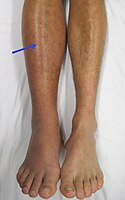
Photo from wikipedia
This study aimed to investigate the cost-effectiveness of low-dose rivaroxaban plus aspirin versus aspirin alone for patients with stable cardiovascular diseases in the Taiwan setting. We constructed a Markov model… Click to show full abstract
This study aimed to investigate the cost-effectiveness of low-dose rivaroxaban plus aspirin versus aspirin alone for patients with stable cardiovascular diseases in the Taiwan setting. We constructed a Markov model to project the lifetime direct medical costs and quality-adjusted life-years of both therapies. Transitional probabilities were derived from the COMPASS trial, and the costs and utilities were obtained from the Taiwan National Health Insurance Database and published studies. One-way, scenario, subgroup, and probabilistic sensitivity analyses were performed to assess the uncertainty. Incremental cost-effectiveness ratio was presented as the outcome. The threshold of willingness-to-pay was set at US$76,368 (3 times the gross domestic product per capita of Taiwan). All analyses were operated by TreeAge 2019 and Microsoft Excel. The incremental cost-effectiveness ratios of rivaroxaban plus aspirin versus aspirin alone in the patients with stable cardiovascular diseases, coronary artery diseases, and peripheral artery diseases were US$83,459, US$69,852 and −US$13,823 per quality-adjusted life-year gained, respectively. The probabilistic sensitivity analyses showed that the probabilities of cost-effectiveness for the regimen with rivaroxaban among those with cardiovascular diseases and coronary artery diseases were 44.1% and 65.3% at US$76,368. Low-dose rivaroxaban plus aspirin is less likely to be a cost-effective alternative to aspirin in secondary prevention for the patients with stable cardiovascular diseases; however, among these patients, the regimen may have pharmacoeconomic incentives for the group merely having chronic coronary artery diseases from the Taiwan national payer’s perspective. The pharmacoeconomic incentives are influenced by the drug price, event treatment fees, and willingness-to-pay threshold.
Journal Title: Cardiovascular Drugs and Therapy
Year Published: 2020
Link to full text (if available)
Share on Social Media: Sign Up to like & get
recommendations!